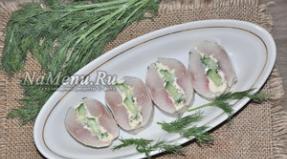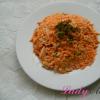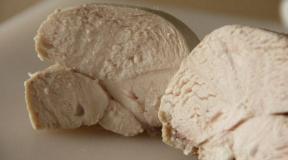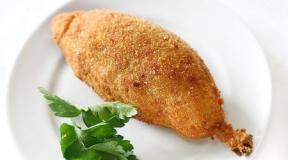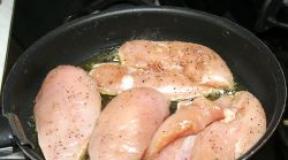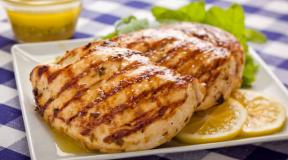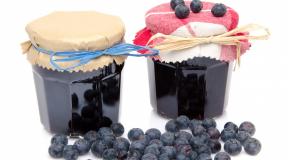Bakhsh plov of Bukharian Jews. Jewish pilaf in a bag
photo April 2017
This recipe fascinated me five years ago, when I was reading the first book by Stalik Khankishiev. Since then, I've been going, going, thinking that I want to try it, but somehow it didn't work out. But recently, studying book, about which I will write a lot of good things, I saw a bakhsh recipe in it and decided that it was fate :))
I haven’t dared to try authentic bakhsh, which is cooked in a linen bag, so I prepared its more modern version - in an ordinary cauldron.
The characteristic features of this pilaf are a very small amount of meat, the addition of a liver and a completely unrealistic amount of greens. When the greengrocer began to weigh it for me, she asked several times if I hadn’t confused anything :)) Chopped greens with a slide filled the laundry basin. But it is just as much as required. Most of it (70-80 percent) was cilantro, there were also a bunch of parsley and dill, an impressive bunch of green onions ... It's a pity there was no basil, I would have put it. But let's go in order.

So I had:
* Rice 900 gr. (not devzira, simpler).
* Lamb - 400-450 gr.
* Kurdyuk - 200 gr.
* Liver (I didn’t get lamb, I took veal).
* Onion - 3 pcs.
* Greens (cilantro, dill, parsley, green onions) - 1 kg.
* Vegetable oil - 50 ml
* Olive oil - 80 ml
* Black ground pepper - 3 tbsp.
* Salt.
Stalik wrote about this and I will repeat - pepper is the only spice in bakhsh and there should be just as much and no less! Its sharpness will soften during the cooking process, and the aroma will nourish the entire contents of the cauldron. It is best, of course, to grind the pepper immediately before use, but we will get to that :))
So, you need very little meat, and therefore I didn’t cut it very carefully from a leg of lamb and cut it very finely. "With two grains of rice" - the ideal to which we need to strive;))
The liver is not so easy to cut, so I cut it into small pieces from a matchbox and blanched in boiling water in a couple of pieces for literally 7-8 seconds. The liver should turn white. After that, it is already much easier to cut it into the same small pieces as meat.
The rice was carefully washed and soaked in hot salted water.
Kurdyuk was cut into even smaller cubes, literally 3 by 3 mm. I have it straight from the freezer, so it was convenient, fresh is better to freeze beforehand.
Greens (only leaves, without sticks) chopped, ground a lot of black pepper.
In a cauldron, she heated the vegetable oil and quickly fried the meat until the color changed.
I added liver and almost immediately - fat tail fat. As opposed to traditionally rendering it over low heat, we fry it so that the pieces turn golden, but at the same time, most of the fat remains inside them. Salted and covered all the pepper. Everything happens very quickly, you can not overcook food.
Gradually laid out all the greens in the cauldron. To make it fit in it, I had to do it in four stages - put, mix, add more. The greens very quickly settle in hot oil and the place in the cauldron reappears :))
When all the greens were saturated with oil (there is no need to fry it, this is enough), I poured about 1 liter of water into the bowl to make a very thick zirvak. There is absolutely no point in cooking him for a long time.
Three onions cut into quarter rings and mixed with rice, from which the water was drained. I added some delicious olive oil. She put the rice on the zirvak, added a little more water and boiled it, as in the usual Uzbek pilaf, until the rice was half cooked, but still slightly elastic to the bite. After that, the contents of the cauldron, contrary to smooth stereotypes, should be thoroughly mixed, waiting until the boiling in the cauldron stops completely.
She closed the pilaf with a lid, put more towels on the lid and left Nazan on the lowest heat for 40 minutes.
Rinse rice thoroughly in several waters. Pour fresh water, salt a little and leave for 3 hours. Cut the meat and tail fat into very small pieces. Cut the liver into thin slices.
Lower the liver for 30 seconds. into boiling water, discard in a colander and chop as finely as meat and lard.
Heat a cauldron or a thick-walled pan, pour in oil, add fat tail fat and fry until cracklings appear. Remove cracklings. Spread the meat in portions, fry over high heat until the meat becomes light. Add liver and cook 4 minutes.
Wash all greens, dry and chop. Peel the onion and cut into half rings. Add greens to the cauldron, cook for 2 minutes, stirring constantly. Pour in 1 liter of boiling water, salt and pepper. Reduce heat and simmer for 40 minutes. Increase the heat and once the broth boils, add the onions.
Rinse the rice again and put it in an even layer in the pan.
Pour boiling water through a slotted spoon. It should cover the rice layer by 2 fingers. As soon as the water leaves the surface of the rice, gradually reduce the heat. Cook until rice is cooked. Remove from heat, stir. Smooth the surface, cover with a plate, then a lid and let it brew for 20 minutes.
bakhsh - pilaf with liver and greens
Bakhsh is the wedding pilaf of Bukharian Jews, an incomparably tasty and original dish. Having prepared it once, you will never refuse this recipe. I will make a reservation right away: traditionally, bakhsh was cooked in a linen bag, this required a good eye and certain experience. I give a simpler recipe, but I do not leave the idea of cooking a real bakhsh in a bag. I thought for a long time which section to attribute the dish to, but the liver plays the main flavor note in it. so .... take the recipe for green pilaf.
Compound
- 500 g liver
- 300 g meat
- 300 g fat tail fat
- 4 large onions
- 500 g rice
- greens (parsley, dill, cilantro, tarragon, basil) in a small bunch
- black pepper
- vegetable oil
Cooking
Wash the rice thoroughly and soak in cold water for at least an hour.
Now you need to prepare the meat. Let's remember that pilaf is Jewish and we will choose lamb or beef, although ... we also eat pork. In general, the choice is yours. For bakhsh, meat is cut into small cubes, and bacon is also cut into cubes.

With the liver, the situation is somewhat more complicated. It is extremely difficult to cut it raw, so we cut the liver into fairly large pieces and boil it in boiling water for 5-7 minutes. Guessed? The liver becomes dense and it is now easy to cut it into thin slices, into sticks and then into 1.5x1.5 cm cubes.
We cut the onion into half rings, chop the greens very finely.
it should turn out equally: meat + lard, liver, onions, herbs, rice
Pour oil into a heated cauldron, wait until it heats up and lay the meat first. stir-fry until lightened. Now it’s the turn of the liver, pour it on top, stir with a slotted spoon, after 5 minutes put the lard in a cauldron, mix again, make sure that the lard does not fry in any case, but languishes, becoming transparent and tender. The lard is ready, pour out all the greens, salt to taste, add 2 teaspoons of ground black pepper and add boiling water so that the water covers the meat with greens.
This is zirvak for bakhsh. We reduce the fire and simmer the zirvak for 30 minutes.
Drain the water from the rice, then in a large bowl, mix it with chopped onions and pour vegetable oil so that all the rice is soaked with it.

We put the prepared rice in a cauldron for zirvak, mix, salt. level the surface with a slotted spoon and add, if necessary, boiling water so that the rice is covered by 1 cm of liquid. Cook on the lowest heat until cooked for about 20-30 minutes. All water must be absorbed.

Mix vigorously again and serve.
Bon Appetit!
Osh-khalta, Jewish pilaf in a bag, bakhsh or green pilaf... This culinary masterpiece belongs to Bukharian Jews. It is believed that Jews cook this dish from Friday to Saturday, since it is a sin to work on Saturday according to Jewish customs. There is also a festive version of "haltadagi savot", but I settled on the everyday one. Bribed me, of course, the method of preparation and the technology itself. Although I took a few liberties, I am quite satisfied with the result. However, see for yourself.
Ingredients for "Jewish Pilaf in a Bag":
Nutritional and energy value:
Recipe "Jewish pilaf in a bag":

1. The Jewish pilaf has several features. Firstly, it is cooked in a bag, secondly, according to all Jewish rules, it is cooked for at least 6 hours, and thirdly, all the ingredients must be cut into small pieces, like rice. In general, the whole technology is absolutely different from the usual pilaf.
So, for starters, I wash and finely chop the greens. I had frozen cilantro, I couldn’t find fresh, I also chopped it finely.

2. Here's what I took liberties with, so it's in the choice of meat. In an authentic recipe, lamb is mixed in half with fat tail fat. But we have an ambiguous attitude towards lamb, it is very difficult to find good lamb and I absolutely do not know how to choose it. So I replaced it with lean beef. The meat must be cut into small pieces, almost like minced meat. It is better to cut slightly frozen meat. True, after cooking, I saw that it was possible to cut the meat even smaller. Peel the onion and chop finely too.

3. The choice of rice for such a pilaf is a very responsible matter, because it faces a difficult task - to cook in the broth for at least two and a half hours and not boil into porridge. I opted for Indica Gold from Mistral. Rice, in theory, should be as much as meat plus tail fat. But since I didn’t take fat separately, I took meat and rice equally.

4. Put meat, rice, onions, greens in a cup.

5. Pour in the oil, add cumin, salt and mix.

6. We spread the resulting minced meat in a bag specially sewn for this. Every self-respecting Bukharian Jewish family has such a bag. It is sewn from thick linen or cotton fabric. We tie the bag so that there is about 10% free space for the rice that has swollen during the cooking process.

7. Bring the broth to a boil. You can take water instead of broth if you use fat tail fat, but I was afraid that if I cook from beef, and even on water, then the pilaf will not be saturated enough. We put the bag on its side so that the broth covers it, set the fire to a minimum, close the lid and almost forget about it for 2.5-3 hours. During this time, turn the bag from side to side a couple of times so that the rice cooks evenly. According to the rules, such pilaf is cooked for 6 hours, or even more, but this time is indicated in the adapted recipes. I cooked for about 3 hours. Then take out the bag. Drain excess liquid from the bag and pour the rice onto a plate. It’s right, of course, to eat rice with your hands, but we cowardly used forks.
I was very worried about the condition of the rice when I opened the bag. It's no joke, 3 hours of cooking, what kind of rice will stand it? But it turned out that in vain, rice passed the test with honor. The rice turned out to be very beautiful, and the whole pilaf looked very interesting and unusual. The greens give it an extra zest, and the use of beef and the cooking method makes it a more dietary option compared to regular pilaf. Maybe this dish will not be a regular guest on our table, but once it is definitely worth a try. Or maybe I will still make up my mind and cook a real authentic version with lamb and tail fat. Especially since I already have a bag.
Bon Appetit!
When I read a long time ago at Stalik's about pilaf of Bukharian Jews with an interesting name "bakhsh".
This entry appeared in Stalik back in 2000, at that time I was sooooo far from the Internet and cooking, I was an unmarried girl, I lived with my parents and knew how to cook a little)) Well, then, due to family circumstances, I had to quickly catch up on communication skills with pots and pans. This is where the books from the section “About tasty and healthy food” and various Internet resources came to the rescue. At first it was local forums, then culinary sites (although I didn’t linger on any), and then I found an interesting platform - a live magazine (LJ), it turned out that much more useful information could be extracted there and it was easier to filter)) , slowly figured it out, friended the magazines she liked, somehow sluggishly wrote herself, and, a few years later, I just found out who Stalik is, and why his name and the word "pilaf" are almost synonymous.
In general, I somehow sat, messed around, delved into the old archival records of this author, and came across a bakhsh recipe. And here's something not impressed...
Then I was also firmly convinced that borsch, for example, should be red and always with onion-carrot frying, and pilaf - well, of course, only lamb, certainly with carrots, zira and raisins, and whole garlic! And only a man will cook it right!
And here in the pictures lay something colorful, but not bright, not at all like pilaf. So I somehow quickly closed the recipe page without even reading it carefully.
Then I again came across the recipe for this "pilaf" in the culinary thread of the automotive forum - several talented culinary specialists often surprised readers with their dishes, and I followed the news with interest - this time I read more carefully. Yeah, the author referred to Stalik - again to that old recipe from 2000. And this time I was surprised at the cooking technology, but again closed the page - well, this is not pilaf! Don't swim!
Only later, after a few more years, I discarded my categorical attitude that “a real pilaf can be from ...”, and, already consciously reading the new book by Stalik Khankishiyev “Pilaf - a culinary study“, I was not at all surprised, for example, pilaf with dolma , or chickpea meatballs, or just boiled in milk and steamed rice with melted butter and honey. So, against the background of the entire line of various pilafs, bakhsh already seemed to be a completely “non-criminal” option)))
And I allowed myself to deviate from the usual combination of products for pilaf in order to try something new, but it was promised tasty, and I was not mistaken!
Bakhsh is a special kind of pilaf, it is boiled rather than fried or stewed. The dish turns out to be so tasty that it is not surprising why not a single feast among the Bukharian Jews can do without it, and this pilaf is served without fail at the end of the gala dinner - as a crown to all the goodies served at the table.
Of the unusual "ingredients" you will need a bag - made of dense undyed fabric (for example, linen or cotton). The most difficult thing in the recipe is to find such a fabric and sew a narrow and long bag out of it.
Particular attention should be paid to the seams - make them hidden. For this, a special double seam is used (usually it is used when sewing bed linen and children's clothing). The two parts are folded with the right side of the fabric inward and connected with a 0.3 cm wide seam. Then the upper and lower parts are turned inside out and stitched with a second line with a 0.5 cm wide seam.
This eliminates the possibility that threads from the bag will get into the finished dish.
In the “classic” recipe, bakhsh is boiled on Friday evening, and on Saturday morning it is removed from the heat and served on the table.
The fact is that Jews are forbidden to kindle a fire on Saturdays (turn on the stove), and there is nowhere to cook food without a hot stove. Wealthy Jews got out of the situation this way - they hired people of a different faith in their service (there is no prohibition for them to work on Saturday). And the Jews simply came up with an amazing thing - they kindled a fire on Friday and heated the oven very much, and then put in it such a dish that needed a long cooking (languishing or stewing). So for the whole weekend they provided themselves with hot and tasty food. Here you go, tricksters!
Of course, in modern realities it is not at all necessary to cook bakhsh all night, it will be ready much earlier. But a tight bag will protect the rice from boiling, so it’s not scary if the dish is cooked longer than the allotted time.
Would need:
- 60 grams of vegetable oil (preferably olive oil)
- 300 grams of lamb or beef meat (only pulp)
- 300 grams beef liver
- 300 grams of fat tail lamb fat
- 1 kg of rice
- two or three bulbs
- two teaspoons ground black pepper
- 8-10 bunches of cilantro
- half a bunch of parsley, dill and green onions
- salt - to taste (1.2 tbsp)
A few notes on the ingredients:
- if you follow all the Jewish canons, then before cooking, the liver must be burned on an open fire;
- fat tail fat can be obtained even in our Siberian region (there is probably everything on the market now!), but if you haven’t found it, or personal dislike, then 300 grams of fat tail can be replaced with 250 g of vegetable oil, and meat can be taken fatter;
- rice must be chosen with special care, in no case sticky, it is best to choose a variety of dev-zira or chungara (both of these rice can be found on the market with Uzbeks who sell spices and dried fruits);
- do not be afraid of such an amount of cilantro - as a result, there will be no obsessive smell of "bugs" at all, but the liquid from the greens will readily absorb the rice.
First of all, we wash the rice in running warm water - drain the water several times, and gently mix the rice with our hands so that the rice grains do not break from rough handling. Then soak the rice for 2 hours in warm water. The water is warm - almost hot - up to 60 degrees Celsius. If soaked in cold water, then the starch that covers the rice will not dissolve in it, and the pilaf will turn out sticky, but if soaked in very hot water, the starch will boil, turn into a paste and it will become almost impossible to wash it off the rice (and again, pilaf become sticky).
Now put the largest pot (or cauldron) on a strong fire - let it boil! In this water we will cook bakhsh, why then wait?
I wrote above that the most difficult thing is to sew a bag in which bakhsh will be cooked, but now the most time-consuming task is ahead - finely chop all the ingredients. How petty? The size of one or two grains of rice!
Cheating fate and using a meat grinder will not work! This, of course, is fast, but the result will be just porridge with meat.
In fact, there are several "tricky" tricks that facilitate such a laborious slicing process:
We do this with the liver: cut it into 2x3 cm cubes, boil water in a small saucepan, and successively lower several pieces of the liver into boiling water (not all at once!), As soon as the water boils again, and the pieces of the liver turn white (after 7-10 seconds ) - we catch it with a slotted spoon, put it on a plate, and lower the next batch of liver into the water. Well, then we cut the liver into very small cubes (like two rice grains). You can take my word for it: if you don’t boil the liver first, you won’t cut it so finely!
And in order to cut the meat and fat more accurately, it can be cut into large pieces and slightly frozen, and then cut into thin slices, then into strips and, finally, into small cubes.
We chop the greens, and cut the onion into small cubes.
Carefully transfer the rice to a colander or sieve and let the water drain. It is not worth pulling out rice and water in advance - if the rice grains dry out, they will begin to crack and break. Therefore, we drain the water at the moment when everything is already cut and it remains only to combine all the ingredients together.
See what an interesting color rice has? This is a variety of dev-zira - it is red in dry form and covered with fine brown powder (evil tongues say that this rice is dyed with brick dust))) After washing in seven waters and soaking in hot water, all red powder is washed off from rice and becomes the groove is clearly visible, and the rice itself is of a non-uniform color - some grains are white, others are translucent ... And from afar, such rice looks like pearl barley))
We combine all the ingredients in a large bowl, add vegetable oil, ground black pepper and salt, mix thoroughly - you get something like minced meat.
And now we fill the bag, shake it so that there are no voids left inside. When cooking, the rice will increase in volume, so leave two fingers of free space on top of the bag and tightly tie the bag with twine. It is important to fill the bag tightly, then the rice will not boil, but will evenly steam.
We put the bag in a large saucepan (I said, boil water in it beforehand!), The water level is such that it completely covers the bag, and set to cook on a slow fire (the water boils weakly, but not violently). Rice will expand, put pressure on the products surrounding it, and the limits of space are limited by the size of the bag, juice will be released from meat and greens, which rice actively absorbs.
After an hour, turn the bag over and cook for another hour - it will be ready!
Of course, some amount of meat juice and fat will go into the water, but bakhsh will also turn out to be light in taste and not sticky-fat!
We take out the bag from the pan, untie it and pour it onto a plate - at first it seems that the rice has stuck together into a lump and it will not work to pull it out of the bag. But shake the bag over the plate and the hotel rice will begin to fall freely, like snow, faster and faster…
If the rice is very soaked or its outer layers are digested, it means that the fabric for the bag is not thick enough!
Surprisingly, with the small size of the bag, I got 500 grams of raw bakhsh mixture into it, and after cooking, the weight increased to 750 grams - these are 2 full-fledged servings that perfectly satisfy hunger without additional dishes, salads, bread or snacks!
In total, I got 5 of these bags and 2500 of the raw mixture.
First, I prepared 1 bag for testing, to see if I added salt and pepper correctly, if the bag was the right size and if 2 hours of cooking was enough. Everything turned out great the first time.
The next day, I sewed 3 more bags, but cooked only 2 for dinner - this was enough for 4 adults to get enough. I spread the remaining mixture in two more bags and put it in the refrigerator, I cooked this portion on the third day, surprising my friends a lot with both taste and technology.
It is noteworthy that even after 3 days, the raw mixture for bakhsh did not change its pleasant smell at all, did not change in color, the rice did not soak, the liquid from onions and herbs did not enter, the cooking time remained the same - 2 hours, and neither the look nor the taste of the finished dish was no different from the first control and successful portion.
Of course, the appearance of the dish is very inferior, for example, to the classic Ferghana pilaf (my mother said that from afar it looks like pearl barley porridge with meat), but bakhsh is perceived in a new way after the very first spoon eaten! This is delicious! Very unusual! Savory and flavorful! You put spoon after spoon into your mouth and cannot figure out what dominates - the taste of liver or lamb meat, or the delicate aroma of greens that rice has been saturated with. Everything is perfect! Well, how great it is that a person many centuries ago came up with such a wonderful idea for this dish!
Also, you know what I thought! This is a wonderful semi-finished product idea!
The raw mixture for minced meat can be prepared at home, stuffing bags in the same place, and in nature, simply boil water in a cauldron or boiler, and cook bakhsh, occasionally controlling the fire so that it does not flare up strongly and does not create a violent boil!
No running around the hearth, convulsive slicing of ingredients, constant monitoring of the contents of the cauldron (still damp, oh, it’s already on fire!), Everything is calm, according to feng shui))
Well, delight and surprise will be over the edge when you pull out such a bag from the cauldron for everyone to see and pour fragrant bakhsh onto a plate!
True, then everyone who tried this miracle will always demand repetition from you))
Enjoy!
